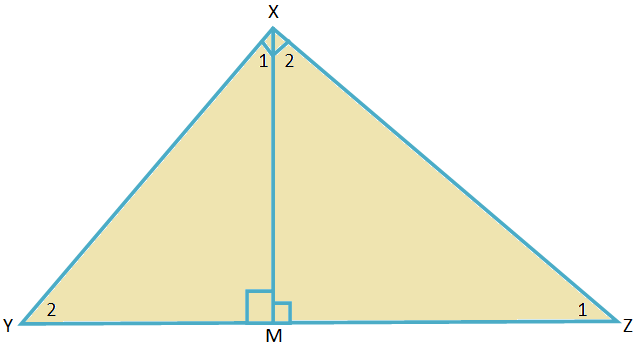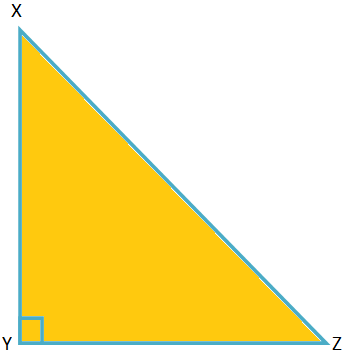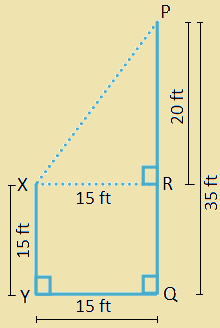Pythagoras’ Theorem
The lengths of the sides of a right-angled triangle have a special relationship between them. This relation is widely used in many branches of mathematics, such as mensuration and trigonometry.
Pythagoras’ Theorem: In a right-angled triangle, the square on the hypotenuse is equal to the sum of the squares on the other two sides.
Given: Let XYZ be a triangle in which ∠YXZ = 90°.
YZ is the hypotenuse.
To prove: XY2 + XZ2 = YZ2.
Construction: Draw XM ⊥YZ.
Therefore, ∠XMY = ∠XMZ = 90°.
Proof:
|
Statement |
Reason |
|
1. In ∆XYM and ∆XYZ, (i) ∠XMY = ∠YXZ = 90° (ii) ∠XYM = ∠XYZ |
1. (i) Given and by construction (ii) Common angle |
|
2. Therefore, ∆XYM ∼ ∆ZYX |
2. BY AA criterion of similarity |
|
3. Therefore, XYYZ = YMXY |
3. Corresponding sides of similar triangle are proportional |
|
4. Therefore, XY2 = YZ ∙ YM |
4. By cross multiplication in statement 3. |
|
5. In ∆XMZ and ∆XYZ, (i) ∠XMY = ∠YXZ = 90° (ii) ∠XZM = ∠XZY |
5. (i) Given and by construction (ii) Common angle |
|
6. Therefore, ∆XMZ ∼ ∆YXZ. |
6. BY AA criterion of similarity |
|
7. Therefore, XZYZ = MZXZ |
7. Corresponding sides of similar triangle are proportional |
|
8. Therefore, XZ2 = YZ ∙ MZ |
8. By cross multiplication in statement 7. |
|
9. Therefore, XY2 + XZ2 = YZ ∙ YM + YZ ∙ MZ ⟹ XY2 + XZ2 = YZ(YM+ MZ) ⟹ XY2 + XZ2 = YZ ∙ YZ ⟹ XY2 + XZ2 = YZ2 |
9. By adding statements 4 and 8 |
Problems on Pythagoras’ Theorem:
1. In ∆XYZ, ∠Y = 90°. If XY = 3 cm and YZ = 4 cm, find XZ.
Solution:
By Pythagoras, theorem,
XZ2 = XY2 + YZ2
= (32 + 42) cm2
= (9 + 16) cm2
= 25 cm2
Therefore, XZ = √25cm2
Therefore, XZ = 5 cm
2. Two poles, 15 feet and 35 feet high, are 15 feet apart. Find distance between the tops of the poles.
Solution:
Let the first pole XY = 15 ft
The second pole PQ = 35 ft.
The distance between two poles YQ = 15 ft.
Draw XR ⊥ PQ.
Now, we have,
PR = PQ - RQ = PQ - XY = (35 - 15) ft = 20 ft.
Also, XR = YQ = 15 ft.
Therefore, distance between tops of the poles = XP
= √XR2+RP2
= √152+202 ft
= √225+400 ft
= √625 ft
= 25 ft
From Pythagoras’ Theorem to HOME PAGE
Didn't find what you were looking for? Or want to know more information about Math Only Math. Use this Google Search to find what you need.
Recent Articles
-
Vertical Subtraction | Examples | Word Problems| Video |Column Method
Mar 22, 25 05:20 PM
Vertical subtraction of 1-digit number are done by arranging the numbers column wise i.e., one number under the other number. How to subtract 1-digit number vertically? -
Worksheet on 11 Times Table | Printable Multiplication Table | Video
Mar 22, 25 05:08 PM
Worksheet on 11 times table can be printed out. Homeschoolers can also use these multiplication table sheets to practice at home. -
Worksheet on 10 Times Table | Printable Multiplication Table | Video
Mar 21, 25 03:46 PM
Worksheet on 10 times table can be printed out. Homeschoolers can also use these multiplication table sheets to practice at home. -
5th Grade Prime and Composite Numbers | Definitions | Examples | Math
Mar 21, 25 12:18 AM
5th grade prime and composite numbers -
14 Times Table | Read and Write Multiplication Table of 14| Video
Mar 20, 25 04:03 PM
In 14 times table we will learn how to read and write multiplication table of 14. We read fourteen times table as:One time fourteen is 14 Two times fourteen are 28 Three times fourteen are 42








New! Comments
Have your say about what you just read! Leave me a comment in the box below. Ask a Question or Answer a Question.